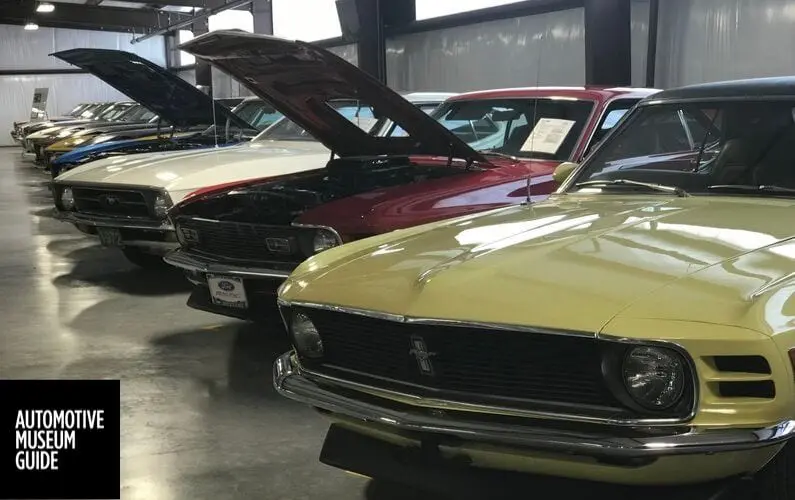A Visit to the Museum of Automobiles and Fashions, Málaga, Spain

Located in a medium-sized city on Spain’s Mediterranean coast, the Museo Automovilistico y de la Moda (Museum of Automobiles and Fashion) combines a large assortment of cars (about 90) with a collection of women’s fashion, both spanning most of the past century.
The museum seems like an art museum, in a building with high ceilings, a spacious interior with inner columns, and a number of works of automotive art displayed among the cars. Many of the dresses, gowns, coats, and other items of clothing are displayed alongside cars of the same period, with many more in a separate room. Vintage luggage also is on display with some of the older cars, and some cars include mannequins in period costumes.
Some of the vehicles are grouped by decade and others are grouped by theme (designer cars, prototypes, customs, etc). Some don’t seem to fit into any theme, but all appear to have been chosen for their historical significance as well as attractiveness or interesting features. The collection is all private cars with no trucks or other commercial or emergency vehicles.
The largest group is from the 1930s, but all periods from the very early days of motoring through the 1980s are represented. A couple have been left purposely in original “found” condition – one of them is a Belgian Minerva (which looks much like a Model T) that served in World War I and still has bullet holes in the rear seat. Several of the cars are unique prototypes or experimental cars, and others are probably the only surviving examples of their type. Several cars are custom creations by the museum staff and others that evoke the American hot rod and customizing scenes.
Countries represented in the collection as of my visit in October 2018 included the United States, United Kingdom, France, Belgium, Italy, Spain, Germany and Czechoslovakia, and a wide variety of manufacturers were represented. Most brands have only one or two vehicles, but several Rolls-Royces, Cadillacs, and Jaguars were present. Quite a few cars are American; for example, the museum has a pair of cars from E.L. Cord’s company, a 1936 Auburn Model 851 and a 1937 Cord 812 Westchester Sedan. The museum seems to have more pre-World War I cars than most auto collections, including a 1903 Dijon-Bouton, a 1910 Stanley Steamer and a 1916 Milburn electric car.

In keeping with the idea of automobiles as works of art, there are some artistic impressions of automotive-related items on display, and some cars have been decorated in unusual ways. Several separately-displayed motors are painted and decorated as objects of art. Swarovski crystals are widely used in the custom creations – adorning everything from a 1934 Ford custom to a 1987 Rolls-Royce – and a 1924 Unic in the museum was painted in bright colors back in the 1920s by famous French artist Sonia Delaunay, the first artist to decorate cars. Decorative human and animal skulls are another common motif, both incorporated into custom cars and mounted atop some of the dress models in a room full of gowns. Other dress dummies are topped by auto headlights.
All of the cars are interesting and most of them are very attractive – a couple are just weird. It was great to see some vintage foreign cars that one would be unlikely to find in the USA apart from some of the top concours events. Some of the cars were a little hard to photograph because of uneven lighting or obstructions, but most of them were lit pretty well and were very accessible, with a fair amount of space between them which makes photography a lot easier.
Among the cars present during my visit, these stood out:
1909 Richmond Model J: One of only two surviving examples in the world, the car was manufactured in Richmond, Indiana, where the only other surviving example resides.
1914 American LaFrance racer: This racing car was built on a fire truck chassis and is the closest thing in the museum to a truck. This may be the only example in Europe, discovered in the 1960s by a British racing driver who was killed shortly afterward driving a Formula 1 car.
1916 Buick Model D44: Displayed with mannequins and luggage, it represents the arrival of the first tourists to Spain’s Costa del Sol (Sun Coast).
1923 Minerva Model 00 chauffeured limousine: This car cost more than a Rolls-Royce in its day. The rear panels are covered with wicker-like paneling and the interior ceiling in the passenger compartment is lined with silk. Minervas were made in Belgium and were the brand favored by the Belgian royal family.
1956 Chrysler Imperial C70 Crown limousine: Only 175 of these were made, intended for heads of state and other big shots. A Crown met Princess Grace when she arrived in Monaco, and another was the President of Portugal’s official car.
1939 Packard Twelve: This car is complete with a wooden “minibar” and glasses in the rear compartment.
1949 Delage 3-liter D6: To me, this car was the most beautiful one in the collection. Philip Delage enlisted a couple of famous artists to make this car special, one of whom designed the crystal eagle radiator mascot. In addition to its beautiful lines and two-tone paint job, the car has ostrich leather upholstery and silver and ivory accents in the interior. It’s surprising to see right-hand drive on a French car, so perhaps this one was built for a British customer.
1938 French Talbot-Lago T23: This car was, in my opinion, the second-most attractive car in a collection full of good-looking autos.

1936 Mercedes-Benz 540K, one of my favorite cars – only 419 were made.
Bugatti 1939 Model 57 Galibier, the only Bugatti in the collection.
1937 Peugeot 402 “Eclipse:” Preceding the Ford Skyliner by exactly 20 years, this Peugeot 402’s retractable hardtop gave it the name “Eclipse.” The roof system, which was used on a number of models, was designed by a dentist, Georges Paulin, who became chief stylist for Carrosserie Pourtout, Peugeot’s coachbuilder, and later was a designer for Rolls-Royce-Bentley. Paulin became a British spy after the fall of France in World War II. He was betrayed and executed by the German occupation forces in 1942. The museum says this car was “buried” during World War II and was one of the most difficult restorations in the collection.
1932 Helicron: A prototype French car from 1932, the Helicron was powered by a surplus WW 1 airplane engine, and its design followed an aircraft motif. A similar car is in the Lane Motor Museum collection in Nashville, TN.
1932 Rolls-Royce wood-bodied “shooting brake” or hunting car.
1932 Ford Model B hot rod: Notable in this example is the exquisite flame paint job and the golden, crystal-encrusted skull on the radiator cap (the museum seems to have a thing about skulls and Swarovski crystals).

1938 Lincoln Zephyr custom: Note the placement of the exhaust pipe.
“La Bomba” (The Bomb): This custom hot rod was built by the museum staff. Very little information was provided about the car, including the original source, but it looks like the body was entirely custom-built and probably just the frame was recognizable from the original source. I spent a long time looking at this car and took a lot of photos of it. Every part of it was fascinating, from the custom wheels to the dual windscreens and headrests, the pointed rear bumper, and the huge blower on top of the engine. The firewall had nothing attached to it at all, just a hole for the steering column. I looked all over the open engine compartment for a battery and gave up. All the components in this area are mounted on the engine itself. Of course they had to put a skull on it too; in this case donated by some animal.
1934 Lancia Dilambda: This was one of Italian Fascist dictator Benito Mussolini’s parade cars. You can almost picture Il Duce standing in the back in his characteristic pose with upraised arm and his chin pointing toward the sky.
1939 Lancia Astura: It seems a lot more elegant and powerful than the earlier Lancia; this particular one was customized for an Italian countess by Pininfarina and included bottles of perfume and jars of makeup in the back seat.
1938 Panhard-Levassor: This French design takes fender skirts to a whole different level by incorporating them into the body fore and aft (must have been tough changing tires). I love the paint job but I’m not sure about the skirts and the clunky-looking headlight screens. Note the three windshield wipers.
1930 Nash Ambassador Series 400: I loved the colors on this one. Other American cars from this period were a 1927 Paige Jewett sedan and a 1930 Pierce-Arrow convertible. The museum touted a 1931 Studebaker FD Commander as an example of the cars used by Chicago gangsters, which probably would be surprising to most Americans more accustomed to Lincolns, Cadillacs, Chryslers and Packards as typical gangster rides, especially in the movies.
German 1955 Fuldamobil S-1 and Czech 1967 Velorex 3-wheeler: These tiny cars are markedly different than the other museum cars of their period (for example, the ’55 Ford Thunderbird and ’55 Gullwing Mercedes-Benz) and would be quite at home in the Lane Motor Museum collection. The Velorex reminded me of a child’s pedal car with a tarp, no doubt marketed as a “people’s car” during the period when that country was a “worker’s paradise.”
1929 Hotchkiss motor: This is only one example of the automotive “objets d’art” scattered around the museum.
Learn more at Museo Automovilistico y de la Moda
Images via Dick Williams
Written exclusively for automotivemuseumguide.com
By Dick Williams
.
Sign up for updates
YOU MAY ALSO LIKE
Visiting Keystone Truck and Tractor Museum
The Keystone Truck and Tractor Museum in Colonial Heights, Virginia is a fantastic automotive museum full of over 150 antique tractors and more.
Visiting the Tampa Bay Automobile Museum
The Tampa Bay Automobile Museum is a must stop place if you're in the Tampa, FL area. If you're cruising out of Tampa take a few extra hours and stop by.
The Panoz Museum
The Panoz Museum in Hoschton, Georgia is a must stop for any automotive enthusiast, especially race fans. Not only is the Panoz hand made right on site but they also display various models in the museum, as well as some of the actual race cars and racing...
Visiting the Mustang Museum of America
I recently had the opportunity to visit the Mustang Museum of America in Odenville, Alabama and I've got to say I was really impressed especially once I was told how recently the museum started.
automotive museum guide
get updates
Sign up to get updates about automotive museums right to your mailbox. Don't miss a thing. It's FREE.



























